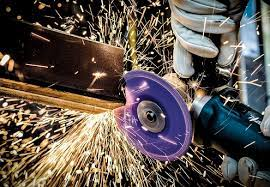An Introduction To Resin Bonded Abrasive Wheel
Bonded abrasive wheel is also known as the consolidated abrasive tools. It is a consolidated it with a certain strength that consolidates ordinary abrasive materials into a certain shape (mostly round, with a through hole in the center) by the binder. It is generally composed of abrasives, binders and pores, which are often called the three elements of consolidation abrasives.There are different application of that, including granite cutting disc and marble cutting disc and so on. It is a kind of abrasive tool with the largest amount and the widest use surface. It can be used for rough thing, semi-finishing,slotting and cutting of outer circle, inner circle, plane and all kinds of surface of metal or non-metal work piece with high speed rotation. According to the different bond, it is mainly divided into follow three cutting wheel types:
- Ceramic bonded abrasive wheel
- Rubber bonded abrasive wheel
- Resin bonded abrasive wheel
From left to right are ceramic, rubber and resin bonded abrasive wheel.
Among them, ceramic bonded abrasive wheel has high strength, good heat resistance, sharp cutting, high abrasive efficiency, abrasive process is not easy to heat and plug, thermal expansion is small, to control the machining accuracy. More elastic than resin binder, good polishing performance, not easy to burn the work piece when used, especially suitable for fine abrasive or polishing process.
What we are talking about today is resin bonded abrasive wheel, which is also more common.
Features of abrasive wheel
Compared with ceramic cutting tools, resin bond CBN abrasive wheel has higher bonding strength, the line speed of resin bond CBN is 80~120m/s, and can bear larger abrasive pressure.
Advantages of resin bonded abrasive wheel.
- Compared with ceramic , resin bonded abrasive wheel has good toughness, certain plasticity and ductility, and is suitable for preparing various specifications of wafer wheel and high-speed cutting wheel. Because of certain elastic deformation, it can buffer the action of force, so the effect is good, and the polishing effect can improve the roughness of the machined surface.
- Due to the low hardening temperature of resin, it can be hardened at room temperature and has small shrinkage rate, so it can be made into various abrasive wheels with complex shapes and special requirements. It is helpful to prevent the work piece from being burned.
- Resin bond heat resistance is low, the work piece in the process of the heat, so that the resin carbonization, promote the passivation of the abrasive off automatically, exposing the new sharp abrasive, reduce the heat in the abrasive area, avoid work piece burn.
Disadvantages of resin bonded abrasive wheel.
However, compared with other bonded abrasive wheels, resin wheel has the following shortcomings:
- Poor alkali resistance, water resistance, easy aging;
- Low heat resistance, large wear, not suitable for shape forming abrasive ;
- Low porosity, processing smell, easy to cause environmental pollution problems.
Conclusion
The above is some introduction of resin bond abrasive wheel. Further understanding is needed for the research of the other two kinds of ceramic and rubber. Choosing the right metal cutting wheel for the job often depends on the goals of the operation. If cutting speed is paramount, then some compromises may have to be made on product life – and vice versa. For more information, please contact us. BINIC-steel cutting disc factory and coated abrasives manufacturer.


